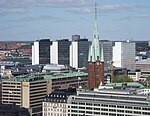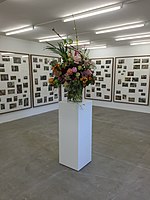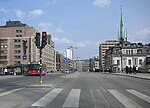Kungsbrohuset
Buildings and structures in Stockholm

Kungsbrohuset (also known as Schibstedhuset) is an office building between Kungsbron and Klarabergsviadukten in the development area of Västra city in central Stockholm. The building was opened on 6 May 2010. Principal architect was Kerstin Heijde of Strategisk Arkitektur.The building has thirteen floors, ten above street level.
Excerpt from the Wikipedia article Kungsbrohuset (License: CC BY-SA 3.0, Authors, Images).Kungsbrohuset
Blekholmstorget, Stockholm Norrmalm (Norrmalms stadsdelsområde)
Geographical coordinates (GPS) Address External links Nearby Places Show on map
Geographical coordinates (GPS)
| Latitude | Longitude |
|---|---|
| N 59.332463888889 ° | E 18.052575 ° |
Address
Kungsbrohuset
Blekholmstorget
111 64 Stockholm, Norrmalm (Norrmalms stadsdelsområde)
Sweden
Open on Google Maps











